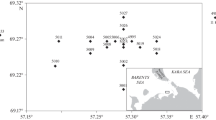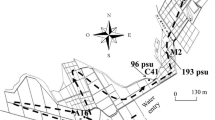Abstract
Spatial pattern in the distribution of the macrobenthos was studied from series of van Veen grab samples taken in a systematic pattern in Lochs Etive and Creran, W. Scotland. Each series was collected in a circular pattern at 7 stations. Plots of the variances of the numerical occurrences of the species in the samples against their means revealed greater deviation from the random expectation in the case of the 2 muddy sand stations than for the soft-mud stations, with only 1 exception. Two tests of goodness-of-fit to the Poisson distribution were also applied. The degree of concordance between the 3 measures of non-randomness applied was measured. The best correlation was found between values of the ratio of variance: mean and the test statistic D of the Kolmogorov-Smirnov goodness-of-fit test. It was not possible to discuss the biological basis for the pattern measured, except for a few species shown to be markedly aggregated. No clear trend emerged from attempts to detect differences in pattern with various ecological groupings of the macrobenthos. However, from the use of the test values as sample statistics illustrative of overall community pattern, it was possible to conclude that the fauna of the shallow, usually current-swept areas of muddy sand in the sea-lochs investigated was more aggregated than that on the, usually deeper, soft-mud sediments in quieter water.
Similar content being viewed by others
Literature Cited
Alley, W. P. and R. F. Anderson: Small scale patterns of spatial distribution of the Lake Michigan macrobenthos. Proc. 11th Conf. Great Lakes Res. 1968. Int. Ass. Great Lakes Res. 1-10 (1968)
Barnes, H.: The use of tranformations in marine biological statistics. J. Cons. perm. int. Explor. Mer. 18, 61–71 (1952).
Bateman, G.I.: The power of the 53-1 index of dispersion test when Neyman's contagious distribution is the alternative hypothesis. Biometrika 37, 59–63 (1950).
Clarke, R. B. and A. Milne: The sublittoral fauna of two sandy bays on the Isle of Cumbrae, Firth of Clyde. J. mar. biol. Ass. U.K. 34, 61–180 (1955).
Cochran, W. G.: Some methods for strengthening the common 53-2 tests. Biometrics 10, 417–451 (1954).
Gage, J.: Community structure of the benthos in Scottish sea-lochs. I. Introduction and species diversity. Mar. Biol. 14, 281–297 (1972).
Greig-Smith, P.: Ecological observations on degraded and secondary forest in Trinidad, British West Indies. J. Ecol. 40, 316–330 (1952).
—: Quantitative plant ecology, 2nd ed. xii+256 pp. London: Butterworths 1964.
Henson, E. B.: Notes on the distribution of the benthos in the Straits of Machinac region. Proc. 5th Conf. Great Lakes Res.; University of Michigan, Great Lakes Res. Div. Publ. 13, 77–95 (1962).
Holme, N. A.: The biomass of the bottom fauna of the English Channel off Plymouth. J. mar. biol. Ass. U.K. 32, 1–49 (1953).
Jones, E. W.: Ecological studies on the rain forest of southern Nigeria. IV. The plateau forest of the Okomu Forest Reserve. J. Ecol. 43, 564–594; 44, 83–117 (1955–1956).
Jones, M. L.: A quantitative evaluation of the benthic fauna off Point Richmond, California. Univ. Calif. Publs Zool. 67, 219–320 (1964).
Kosler, A.: Distributional patterns of the eulitoral fauna near the isle of Hiddensee (Baltic Sea, Rugia). Mar. Biol. 1, 266–268 (1968).
Nielen, G. C. J. F. and J. G. P. Dirven: De nauwkeurigheid van de plantensocialogische 1/4 du2 frequentie-methode. (The accuracy of the 25 cm2 specific frequency method). Versl. landbouwk. Onderz. Ned. 56, 1–27 (1950).
Pearson, T. H.: The effect of industrial effluent from pulp and paper mills on the marine benthic environment. Proc. R. Soc. (Ser. B) 180, 469–485 (1972).
Pielou, E.C.: An introduction to mathematical ecology, 286 pp. New York: John Wiley 1969.
Ricker, W. E.: The benthos of Cultus Lake. J. Fish Res. Bd Can. 9, 204–212 (1952).
Rosemberg, R.: Benthic faunal recovery in a Swedish fjord following the closure of a sulphite pulp mill. Oikos 23, 92–108 (1972).
Sanders, H. L.: Benthic marine diversity and the stabilitytime hypothesis. Brookhaven Symp. Biol. 22, 71–81 (1969).
Siegel, S.: Nonparametric statistics for the behavioral sciences, 312 pp. New York: McGraw Hill Book Company Inc. 1956.
Tidmarsh, C. E. M. and C. M. Havunga: The wheel-point method of survey and measurements of semi-open grasslands and karoo vegetation in South Africa. Mem. bot. Surv. S. Afr. 20, pp iv+49 (1955).
Ursin, E.: A quantitative investigation of the echinoderm fauna of the central North Sea. Meddr Kommn Danm. Fisk.-og Havunders. (N.S.) 2, 1–204 (1960).
Wade, B. A.: A description of a highly diverse soft-bottom community in Kingston Harbour, Jamaica. Mar. Biol. 13, 57–69 (1972).
Author information
Authors and Affiliations
Additional information
Communicated by J. H. S. Blaxter, Oban
Rights and permissions
About this article
Cite this article
Gage, J., Geekie, A.D. Community structure of the benthos in Scottish sea-lochs. II. Spatial pattern. Marine Biology 19, 41–53 (1973). https://doi.org/10.1007/BF00355418
Accepted:
Issue Date:
DOI: https://doi.org/10.1007/BF00355418




